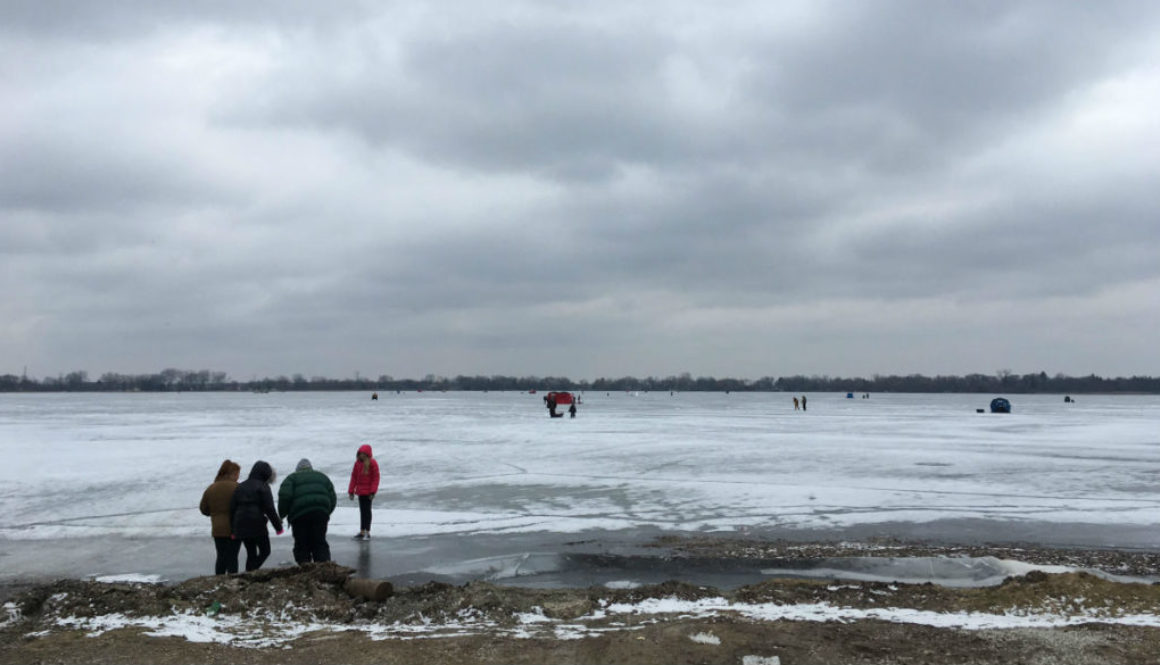How to do Ice Fishing in Wisconsin
With Wisconsin’s long and harsh winter, the season can seem very dull and depressing. The cold keeps the people from leaving their homes and even downtown Milwaukee can feel like a ghost town on Friday nights. But there are definitely some fun activities out there if you are bold enough to face the cold. Besides snowmobiling and skiing, ice fishing is definitely one of the biggest hobbies of Wisconsin in the winter.
I had the chance to take a peek at this sport together with my co-worker Tim and his family, who introduced me to their favorite activity and family ritual in Wisconsin’s cold winter. In the following article I won’t only tell you about my experience out on the ice but also give you a little “how to” on ice fishing based on the Wisconsin traditional way. At the end I will share some insider tips with you from Tim whose family ice fishes on the frozen lakes of Wisconsin for generations.
1. Go out there and see for yourself what it’s like!
read moreHobbies which require a lot of equipment can get costly easily. Especially when you realize after buying and trying it out the first time that you don’t like your new hobby at all. I would therefore recommend to go out there and talk to some people first in order to get some advice and a feeling for what the sport is like. Probably they even have a second fishing pole for you to try. Maybe you even have a few friends who do ice fish. Just ask them to take you out.
In my case my co-worker was telling me about it and I thought it would be cool to try, so he hooked me up. If you don’t know anybody who ice fishes, you can probably make some new friends by going out there and ask them about their hobby. After all what else brings people better together than common interests, especially when they are fun.
2. Get the required equipment and license
read moreAfter you decided to make ice fishing your hobby it’s time to get the right equipment. Like with every sport there are no price limits when it comes to equipment. But you don’t have to spend a fortune to catch fish, the following list contains the minimum equipment requirements.
Minimum:
- Jigging rod: It’s your main tool for ice fishing, the short fishing pole which comes handy while standing or sitting over the hole.
- Hooks: a couple of small 10 or 12 hooks are required to attach the bait and later to catch the fish.
- Bait: Some kind of maggot will do the job.
- Bucket: The bucket can be used to store the fish as well as a seat.
- Ice Auger: That is the tool used to drill holes into the ice.
Optional:
- Skimmer: A tool which is used to clean off the ice from the hole. Looks like a big table spoon with holes.
- Hook disgorger: A tool which helps you to take the fish from the hook.
- Tip-ups: It is basically a trap with a living bait for bigger fish like northern pikes. A tipped up flag indicates a bite.
- Living bait: Shiner, are little shining fish which are used as bait to catch big fish.
- Sled: Helps you to transport your equipment to and from the ice.
- Shanty: A shelter which protects you from the wind and cold.
- And more: There are no limits to the professional….
Before you buy the stuff ask your new friends if they can borrow stuff for the beginning. Check if there are places to lease the equipment if you just want to try it for a weekend. Craigslist is always a good place to find cheap equipment second hand. Make sure you have the license to be allowed to fish. Regulations may vary from state to state. For Wisconsin check out this official governmental Site . There are usually also license free weekends during the season!
3. Plan your trip out to the ice.
read moreCheck on the weather and make sure that it has been freezing temperatures below 34 F (0 C) for the past weeks. The ice has to be at least 4 inch (10cm) thick. Check on the internet for a lake close by which is suitable for ice fishing. Make sure to inform friends that you intend to go and better go in company. We went to the Wind lake to take part in the yearly fishing jamboree by the local Lions club near Muskego 30 min South-West of Milwaukee. That’s where Tim and his family is going to ice fish for years.
4. Make sure you are dressed warm and according to the weather conditions.
read moreI would say this is probably the most important factor for having a good time. Better dress two layers too warm. You can always take clothes off if necessary. Since you are just sitting still and most likely within a harsh wind you will feel cold pretty quickly in your regular winter clothes. This is definitely the reason why my first time ice fishing was a real torture. Although I thought I would be dressed way too warm in my thickest winter clothes, I was already freezing before we even started fishing and it was only 23 F (-5 C). The wind and sitting on ice makes a huge difference. The cold crawls up through your boots and gets into your legs really quickly until your whole body is just shivering. Therefore really thick boots with woolen socks and thick snow pants are key!
5. Access the lake safely and find a good spot
read moreThe ice conditions on a lake can differ throughout the lake. It’s important therefore to follow the right track onto the ice. Again it makes sense to talk to locals and other ice fishers, safety comes first. Just last week an older man died while being out on Lake Geneva early in the morning. Make sure you are not alone! When accessing the lake take care of the borders of the ice because they are the thinnest. As soon as you are on the ice itself you should be fine. Look out for old ice holes, cracks and wet or slushy spots on the ice. Make sure to look back at the spot you entered the lake on, because on large lakes you might lose your orientation quickly.
How to find the right spot? Well this often based on the knowledge of the experienced ice fisher who knows his lake well and can tell you where the fish hide. In the beginning you should just take an area close to people who are already fishing. We parked the cars at the Sportsman’s Landing a cozy little pub where the jamboree would take place later that day. Afterwards we went over to the house of one of Tim’s local friends and asked him for the conditions. After we accessed the lake safely we went to a Tim’s favorite spot on the lake.
6. Drill holes into the ice
read moreWe started to drill a couple of holes probably 5 feet (1.5m) away from each other for the jigging. Afterwards we drilled another 3 holes about 20 (6m) feet away from the center for the tip-up traps. Make sure that you don’t drill into old holes on the ice, this might lead to cracks which you should prevent. During the drilling a lot of slush piles up next to the holes, some remains even in the holes. So we started to clean off that ice with the skimmers we brought.
7. Set up the equipment
read moreWe installed the tip-up traps after the holes were drilled. These traps are simple wooden frames with a flag connected to a spring and a line and a hook with living bait, a little fish called shiner. As soon as a fish chucks the shiner and tries to swim away he triggers the trap which is tipping up the flag. Back at the center we unpacked our jigging rod and unwrapped the line. Make sure the line is as long as from the floor to your nose tip. In order to adjust the length you have to pull out the toothpick from the float and move it to the right spot on the line. Attach the bait to the hook and make sure that the hook is completely hidden within the bait.
8. Start the fishing
read moreNow we come to the fun part, since the tip-ups work mainly on its own I will explain the jiggling more in details:
- Let the hook with the bait sink down into the hole.
- Move the rod slowly up and down or sidewise, you don’t want to scare the fish away but you want to tease him so that he is taking a bite.
- Let the jiggling rod sit for a while and start over again.
- If no fish is biting, change the hole after 45 min.
If you curious about the fish you can catch and the minimum size and limits you can catch please refer again to the governmental site, keep in mind that sizes can vary sometimes depending on the lake too.
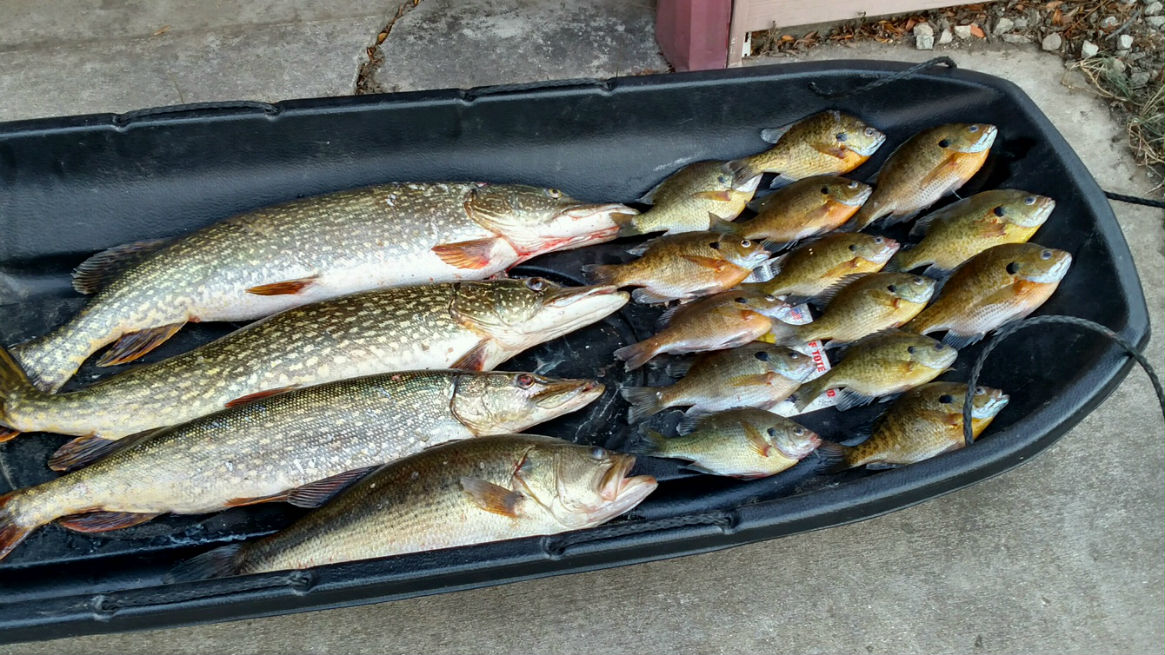
Back to my first ice fishing experience.
Saturday Morning 5 am
I definitely didn’t follow the first Ice Fishing role. Already when Tim was explaining me these basic rules of ice fishing the fingers in my gloves and my feet started freezing. It was even painful to put the bait on the hook because of the cold wind which touched my bare skin after taking off the gloves. Luckily Tim brought a second pair of thicker gloves with him and his cousin let me sit in his shanty which kept me out of the wind. The fishing was going really slow that day, but I caught my first fish a perch after about an hour. After moving the rod slowly to the right of the hole it bit and I could easily pull it out. It was a little bit short but because the fish is more rare than a bluegill we kept it for the competition.
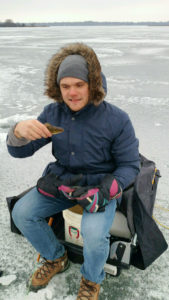
When pulling back the shanty to show my prize it got really cold again and I started to shiver on the whole body which was maybe beneficial for the jiggling but definitely not for my health. It got so bad that I didn’t even want to leave the shanty after Tim’s cousin caught his first northern pike through a tip-up. Eventually I left the shanty and saw him fighting to pull this beast to and out of the hole. Later that day he should win the jamboree competition for the northern pike with this 31 inch exemplar. This fish was a real beast. Tim’s cousin Dan was bitten and started to bleed when pulling out the fish. We put the fish into the shanty behind my seat. It would still move heavily for the next few hours.
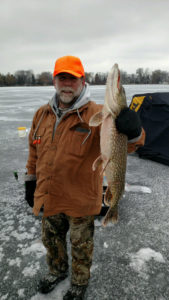
Lunch time
I felt really cold again when I was sitting in the shanty again. While jiggling and staring at the whole at the bottom of the shanty I started to feel really tired. When snoozing off for some seconds my consciousness in the back of my mind told me that I should rather stay awake or I would not likely wake up again. After 5 hours out there in the cold and no more caught fish I asked Tim how long they planned on staying with the intention to leave. I pulled myself together and swapped to the next hole and fished for another hour and caught my first bluegill.
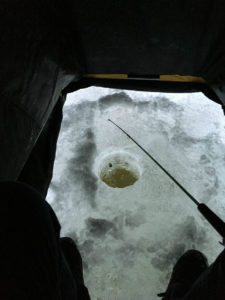
By now I was so cold that I just couldn’t stand it anymore. So I talked to the guys and walked back to the car. I had a really hard time to keep my orientation after sitting in the dark shanty for hours. Eventually I made it back to the truck swearing to myself never to go ice fishing again.
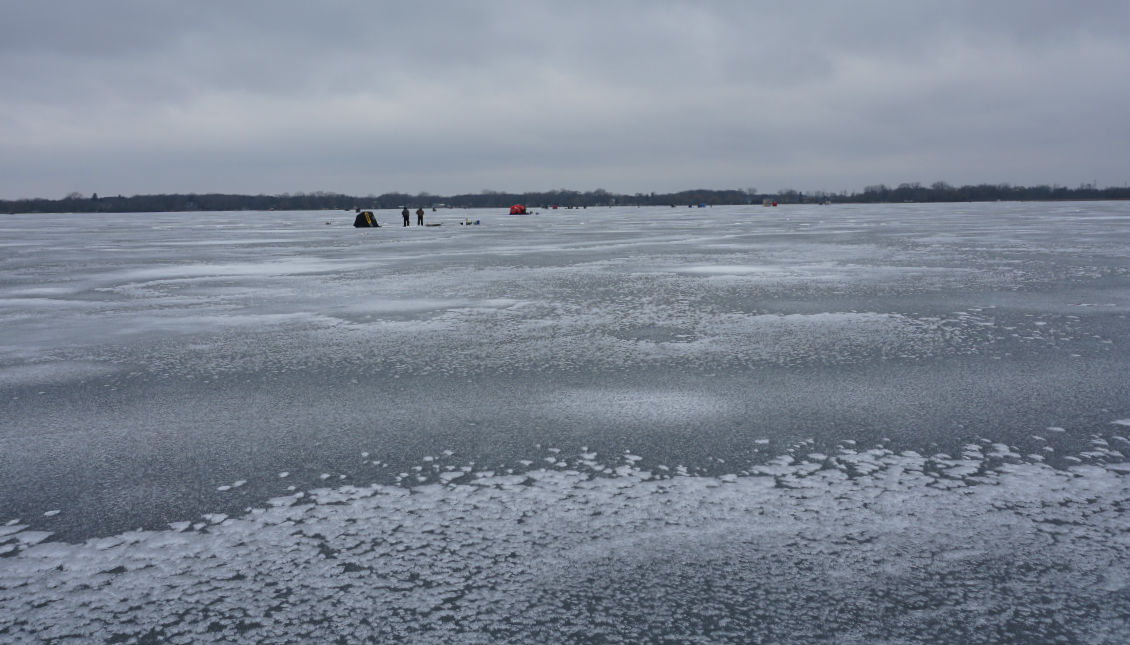
As soon as I started the engine to heat up the car I fell asleep. An hour later the guys woke me up and we went back to the Sportsman Landing to claim our prices. I was still feeling really cold, but after a few hot coffees I started to feel better. Refreshed I realized that ice fishing was actually a really good time. I will definitely go ice fishing again! This time with the right clothes though. Definitely I recommend you to check Ice-Fishing out for yourself!

